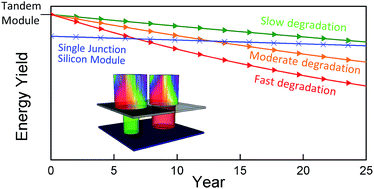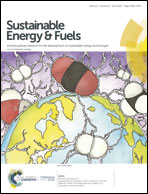Impact of perovskite solar cell degradation on the lifetime energy yield and economic viability of perovskite/silicon tandem modules†
Abstract
With continuously increasing power conversion efficiency, metal halide perovskite solar cells have emerged as promising candidates for high-efficiency silicon based tandem solar cells in two-terminal monolithic integration and four-terminal mechanical stack architectures. The stability of perovskite solar cells is currently one of the major challenges for perovskite/silicon tandem devices and is improving rapidly. However, different degradation rates of perovskite cells and silicon cells in a tandem solar module can affect the overall module degradation. The lifetime energy yield and economic viability of perovskite/silicon tandem modules strongly depend on the degradation rates of perovskite cells. In this paper we present a simulation study of the long term power and energy yield of perovskite/silicon tandem modules under different perovskite cell degradation scenarios. We also estimate the efficiency and cost requirements for the economic feasibility of two- and four-terminal tandem modules. We determine that to maintain 80% of the initial power in a tandem module after 25 years, the maximum permissible perovskite top cell degradation rates are 0.9% per year in a two-terminal configuration and 1.3% per year in a four-terminal configuration for a realistic perovskite cell degradation scenario. We project that a future perovskite/silicon tandem module can produce over 10% more lifetime energy than a single-junction silicon module in 2025 assuming a tandem cell efficiency reaches of 28% and a modest perovskite cell degradation rate of 2% per year. Finally, we estimate the levelized cost of energy for both two- and four-terminal tandem modules. In the case of a degradation rate of 2% per year of the perovskite cell and 50% additional cost for the tandem structure compared to single-junction modules, we find that power conversion efficiencies of 28.7% and 27.6% enable the economic viability of two- and four-terminal perovskite/silicon tandem modules. Our study demonstrates the quantitative impact of perovskite cell degradation on the long-term performance of silicon based tandem modules, and will provide guidance for future commercialization of perovskite/silicon tandem solar modules.



 Please wait while we load your content...
Please wait while we load your content...